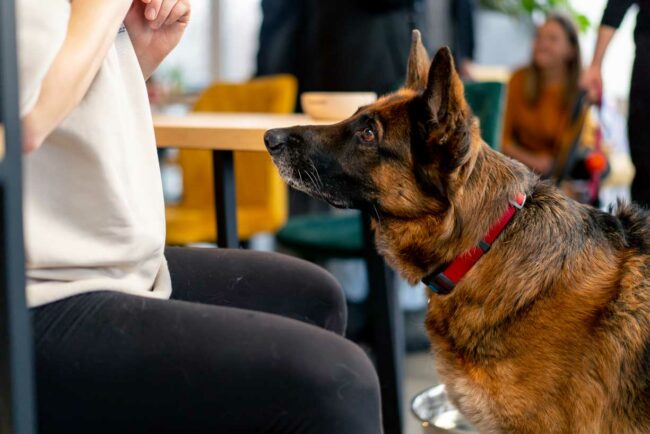Training your dog not to jump is one of the most important behaviors you can teach your furry friend. It is a common behavior, especially for enthusiastic puppies eager to show affection, but it can also be unsafe. With consistent training and positive reinforcement, you can transform your bouncy pup into a well-mannered companion.
Why Do Dogs Jump?
Dogs jump to greet people, show excitement, and — most importantly — to get attention. Understanding that attention is the reward they are seeking is key to eliminating this behavior. Training your dog not to jump up is a process, especially if they’ve never been taught appropriate ways to interact. The first part involves breaking the habit of jumping, and the second part is teaching them what to do instead.
1. Ignore the jumping. When your dog jumps, say “off” turn around, avoid eye contact, talking, or touching. Once all four paws are on the ground, give attention, praise, and treats, like Tricky Trainers. The challenge for this method is that not everyone will know to do this. If someone unexpectedly comes to your door, they won’t know to ignore your dog and may unknowingly give your dog the attention it wants, reinforcing the undesired behavior. As much as possible, share your training rules with family and friends to stay consistent and avoid confusing your dog.
2. Manage the environment. Use a baby gate or keep your dog on a leash when guests walk in the door. Encourage your guests to ignore your dog, then introduce them to the guests after they have calmed down. Reward calm greetings with treats and praise. These are both good interim solutions while you are working on proper greetings.
3. Teach them what to do instead of jumping. Decide what you want your dog to do when people approach them or come to your door. For example: Train them to sit for a greeting. Bring a handful of training treats with you when you go for a walk or to a park. If someone approaches your dog and wants to pet them, get your dog’s attention and tell them to sit. Reward the sit with treats and praise. While they’re still sitting, allow the person to pet your dog and give treats the entire time your dog keeps all four paws and tail on the ground. You can practice this at home, too. From across the room, ask your dog to sit, then walk toward them. If they stay sitting, reward them with their favorite treats. If they get up, turn around and walk away.
Train them to sit for a greeting. Bring a handful of training treats with you when you go for a walk or to a park. If someone approaches your dog and wants to pet them, get your dog’s attention and tell them to sit. Reward the sit with treats and praise. While they’re still sitting, allow the person to pet your dog and give treats the entire time your dog keeps all four paws and tail on the ground. You can practice this at home, too. From across the room, ask your dog to sit, then walk toward them. If they stay sitting, reward them with their favorite treats. If they
get up, turn around and walk away.
Train them to go to their crate or bed. After your dog masters how to “stay”, teach them to go to their calm place, like a bed or crate, and stay there until called. First, name this spot so your dog knows what it is, like “crate”. Repeat the name while your dog is in it. Give treats whenever they go to it, so they associate it as something positive. Next, have them go to this spot and stay. Take a few steps back, and call them to receive their treat. Do this multiple times, each time stepping further away. Once this is clearly understood, add a knock on the door or a doorbell while they’re in a stay. If they come running to the door, ignore them. If they stay, lavish them with treats and praise. With consistency, you should be able to tell your dog to go to their crate or bed and stay there calmly, even if guests have entered your home.
As with all dog training, consistency, timing, and the right rewards are key. Training treats should be highly motivating (aka they should smell and taste irresistible!) to keep their attention, and treats should be small and low in calories so they don’t fill up and cause them to lose focus.
Training your dog not to jump is training your dog how to appropriately interact with people, which is essential to live your life with your dog by your side.™ Once they understand how to greet other people calmly and politely, there is no limit to your adventures together!
